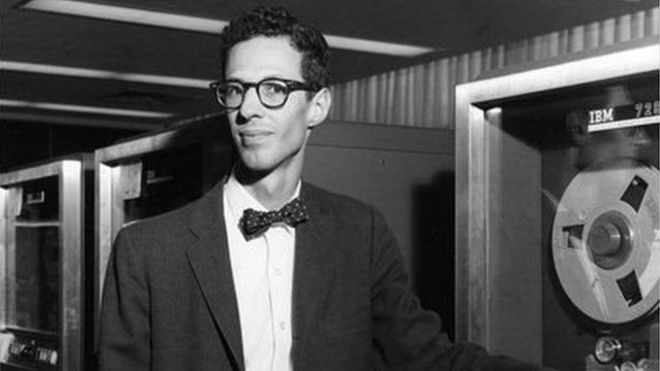The next time you think of all the system passwords you use — or forget — thank Fernando Corbató.
Corbató is the former professor and computer scientist at MIT who invented the password, and like them or not, we owe the man our gratitude for digital security and the way we protect information that’s valuable to us.
We also owe Corbató our respects. As his friends and colleagues affectionately called him, “Corby” passed away July 12th at the age of 93.

What’s ironic in being remembered for the password, however, is that Corbató came to despise his online security measure as much as the rest of us. In a 2014 article on gizmodo.com, he even admitted to author Adam Clark Estes that passwords had become more of a nuisance than a help. Estes cited what Corbató told The Wall Street Journal at the time. “’Unfortunately it’s [the password] become kind of a nightmare with the World Wide Web,’ Corbató said. ‘I have to confess, I used to use a crib sheet… Three typed pages. Probably 150 passwords over the years.’”
One more reason to dislike passwords, along with the little black books we hide them in.
But good side, Fernando Corbató and his password idea did something far more profound. He made the emerging computer industry think about things like cybersecurity and a user’s privacy, and why tools like passwords were needed.
The first operating system… Inherent hackfest!
The security backstory is that Corbató — who was at MIT in the early ‘60s when computers, operating systems, and programming languages started to come together — actually devised the password as a byproduct of his development work on the Computer Time-Sharing System, or CTSS.
In the computer sphere, CTSS is recognized as the first operating system to ever be put in use. When Corbató and his team developed it, the system’s purpose was to speed the pace at which programmers could work by allowing complex mathematical programs to run in a queue. Objective accomplished. Programming became a faster process.
The problem was, CTSS also allowed multiple programmers to use the same computer at the same time.
So, being the inquisitive types they were, CTSS users quickly realized they could interrupt the activities of every other user in what was basically a wide-open environment. Thus passwords for everyone. As Corbató himself explained it, CTSS needed some kind of mechanism to keep people from “needlessly nosing around in everybody’s files.” And for the first time anywhere, passwords let users working on a shared computing system establish their own private accounts to protect their work.
The threads to Multics, UNIX, a digital revolution, and the history of artificial intelligence at MIT
Matthew Hughes paid a heartfelt tribute to Corbató in his July 13th post on thenextweb.com.
For instance, it was CTSS that led to early versions of email, instant messaging, and word processing. It also enabled programmers to write code using a text editor called QED. QED was the predecessor of ed, vi, and vim, and a computer scientist named Ken Thompson contributed to its development by adding QED’s ability to select and edit text with regular expressions.
Thompson later designed Google’s Go programming language.
Back to Corbató, his research efforts after CTSS led to Multics, i.e., the Multiplexed Information and Computing Service. The Multics mainframe time-sharing operating system was introduced in 1965 to provide secure computing for remote users at their terminals. And as a prototype of a computer utility, it has heavily influenced OS development ever since. As Hughes also pointed out, Multics “partially” inspired UNIX, and was one of the tools computer gurus Dennis Ritchie and Brian Kernighan used to develop the C programming language.

Yet Corbató’s best achievement might have been how his work inspired MIT to launch Project MAC, the precursor to its Laboratory for Computer Science. When the CS lab later merged with MIT’s Artificial Intelligence Lab, it gave us the institute’s Computer Science and Artificial Intelligence Laboratory — known as the MIT CSAIL. Today, CSAIL’s 900 researchers are making advancements in AI that are beyond mind-boggling, like their new AI for robots that can “feel’ an object just by seeing it.
And granted, CTSS and Multics essentially ran parallel to MIT’s early AI work. But as with everything Corbató developed, both creations were crucial building blocks to bigger things. Without them, MIT CSAIL might never have happened. Nor would we have the modern version of agile design.
As a former MIT colleague on the CTSS project recently pointed out, Corbató’s time-sharing principles were essentially agile design in its earliest form. The practice is even finally making its way into AI circles as data scientist teams are steadily adapting an agile AI approach.
Call it Fernando Corbató’s ongoing influence.
The digital revolution lives on
“It’s no overstatement to say that Corby’s work on time-sharing fundamentally transformed computers as we know them today,” said CSAIL director Daniela Rus in still another tribute to Corbató in Sky News. “From PCs to smartphones, the digital revolution can directly trace its roots back to the work he led at MIT nearly 60 years ago.”
As far as the password, was it “ground-breaking”? Hard to say if professor Corbató viewed it that way. But given his invention and reasoning, he did realize cybersecurity would be crucial for the computer and digital movements that were taking shape at the time. And for that, we should be thankful.
Rest in peace, Mr. Corbató. Rest^In35peace*
Learn more
ClearObject isn’t MIT. But we know our stuff when it comes to IoT Engineering and how things like artificial intelligence and machine learning fit into your IoT equation. We also take passwords and your system security very seriously. Contact us.
#Passwords #digitalsecurity #CTSS #thedigitalrevolution #historyofartificialintelligence

